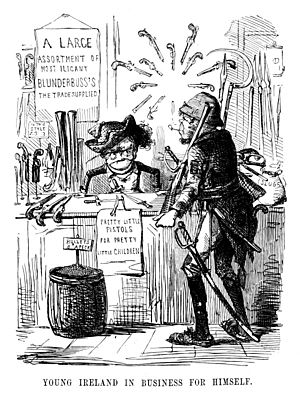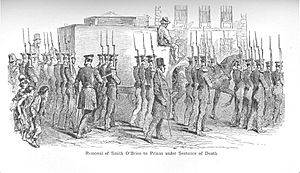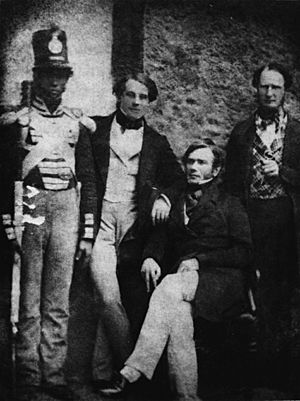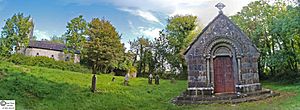William Smith O'Brien facts for kids
Quick facts for kids
William Smith O'Brien
|
|
|---|---|
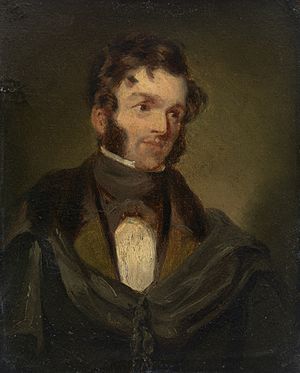
Portrait by George Francis Mulvany
|
|
| Born | 17 October 1803 Dromoland, Newmarket on Fergus, County Clare, Ireland
|
| Died | 18 June 1864 (aged 60) |
| Resting place | Rathronan Cemetery, Ardagh, County Limerick, Ireland |
| Education | Trinity College, Cambridge |
| Known for | Irish nationalist MP, leader of the Young Ireland movement |
William Smith O'Brien (Irish: Liam Mac Gabhann Ó Briain; born October 17, 1803 – died June 18, 1864) was an important Irish leader. He was a Member of Parliament (MP), which means he was elected to represent people in the British government. He also led a group called the Young Ireland movement. He wanted to encourage people to use the Irish language.
William Smith O'Brien was found guilty of a serious crime against the government because of his part in the Young Irelander "Famine Rebellion" in 1848. He was sentenced to death, but this was changed to being sent away to Van Diemen's Land (which is now Tasmania, Australia). In 1854, he was allowed to leave, but he had to stay out of Ireland. He lived in Brussels for two years. In 1856, he was fully pardoned and came back to Ireland. However, he never took part in politics again.
Contents
Who Was William Smith O'Brien?
His Early Life and Family
William Smith O'Brien was born in Dromoland, Newmarket on Fergus, County Clare, Ireland. He was the second son of a wealthy family. His mother's name was Charlotte Smith. When he inherited property from her family, he added "Smith" to his name. He lived in a house called Cahermoyle House in County Limerick.
He was a descendant of Brian Boru, a famous Ard Rí (High King of Ireland) from the 11th century. This means he came from a very old and important Irish family.
His Education and Early Career
William Smith O'Brien went to top schools in England, including Harrow School and Trinity College, Cambridge. After that, he studied law in Dublin and London.
From 1828 to 1831, he was an MP for Ennis. Even though he was a Protestant and a landowner, he supported Catholic Emancipation. This was a movement to give Roman Catholics more rights in Ireland. He also supported the idea of Ireland remaining part of the United Kingdom.
In 1835, he became an MP for Limerick County. He sometimes disagreed with Daniel O'Connell, another important Irish leader. For example, they disagreed about secret voting in elections and about giving money from the government to Catholic priests.
William Smith O'Brien stayed in the British Parliament until 1849.
Leading the Young Irelanders
Joining the Repeal Association
In 1843, William Smith O'Brien joined Daniel O'Connell's Repeal Association. This group wanted to end the union between Ireland and Great Britain. He became part of a group within the association that published a newspaper called The Nation. O'Connell called this group "Young Ireland" because they were like a similar group in Italy.
The Young Irelanders wanted to achieve Ireland's independence. They believed in using any means necessary, as long as it was honorable and fair.
Forming the Irish Confederation
Later, O'Connell and his son disagreed with the Young Irelanders because they refused to promise they would never use force to achieve their goals. So, Smith O'Brien and the Young Irelanders left to form a new group called the Irish Confederation. Smith O'Brien tried to bring the groups back together, but O'Connell died in 1847.
The Confederation wanted Ireland to be an independent nation. They believed in fighting for this goal if needed. Smith O'Brien, as a Protestant landowner, was chosen to lead the group.
The Great Famine and Calls for Action
As the Great Famine got worse, Smith O'Brien worked to organize help for people. By 1848, the famine was so terrible that all the groups in the Irish Confederation agreed that Ireland needed its own government to deal with the crisis.
In March 1848, Smith O'Brien called for a "National Guard" to be formed. He was arrested but found not guilty of trying to cause trouble. In May, a newspaper article suggested that if Ireland was to become independent, it should be a Republic.
The British government decided to use strict rules to control Ireland. Another leader, John Mitchel, was arrested under new laws. On July 9, 1848, Charles Gavan Duffy, another important Young Irelander, was also arrested. His newspaper was shut down.
The 1848 Rebellion
Plans for a rebellion were already underway. In March 1848, Smith O'Brien and Thomas Francis Meagher visited Paris and hoped France would help Ireland. There was also talk of help from Irish-Americans and a group in England called the Chartists.
With Duffy arrested, it was up to Smith O'Brien to lead the rebellion. On July 23, Smith O'Brien, Meagher, and John Dillon gathered a small group of people in Kilkenny. They raised a new flag, a tricolor (green, white, and orange), which they had brought from France. The colors were meant to show unity between Catholics (green) and Protestants (orange).
As Smith O'Brien moved into County Tipperary, many people watched, but he only had a few hundred men. Most of them were poorly dressed and didn't have many weapons. They quickly scattered after a small fight with the police, which was jokingly called the "Battle of Widow McCormack's Cabbage Patch."
Trial and Exile
Smith O'Brien was put on trial and found guilty of a very serious crime against the government. He was sentenced to death. However, many people signed petitions asking for him to be spared. About 70,000 people in Ireland and 10,000 in England asked for mercy.
On June 5, 1849, his sentence and the sentences of his friends Meagher, Terence MacManus, and Patrick O'Donoghue were changed. Instead of death, they were sent away for life to Van Diemen's Land (now Tasmania, Australia).
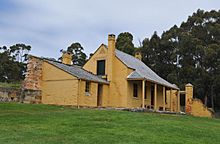
Smith O'Brien tried to escape from Maria Island off Tasmania, but he was caught. He was then sent to Port Arthur, where he met John Mitchel, another Irish leader who had been sent there earlier. The small houses where Smith O'Brien lived on Maria Island and at Port Arthur are still there today as memorials.
In 1854, after five years in Tasmania, Smith O'Brien was released. But he was not allowed to return to the United Kingdom. He moved to Brussels. In May 1856, he received a full pardon and returned to Ireland that July. He wrote for The Nation newspaper and published a book called Principles of Government, or Meditations in Exile. Even though some people wanted him to lead again, Smith O'Brien did not take part in politics anymore.
In 1864, he visited England and Wales because he was not well. He died in Bangor, Wales, on June 16, 1864.
His Legacy
Famous Quotes
- "The new Irish flag would be Orange and Green, and would be known as the Irish tricolor."
- "To find a gaol in one of the lovliest spots formed by Nature in one of her loneliest solitudes creates a revulsion of feeling I cannot describe." (November 1849, when he first saw Maria Island.)
Memorials and Honors
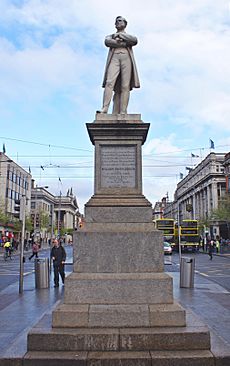
There is a statue of William Smith O'Brien in O'Connell Street, Dublin. It was created by Thomas Farrell and put up in 1870. It was moved to its current spot in 1929.
A road in Limerick city is named Smith O'Brien Avenue after him. Also, the Smith O'Brien's GAA sports club in Killaloe, County Clare, is named in his honor.
In the United States, O'Brien County, Iowa is also named after him.
Supporting the Irish Language
William Smith O'Brien helped start the Ossianic Society. This group wanted to support the Irish language and publish old Irish stories.
He wrote to his son from Tasmania, telling him to learn Irish. He studied the language himself and used an Irish-language Bible. He also gave old Irish manuscripts he had collected to the Royal Irish Academy. Irish poets respected him, and in 1863, because of his advice, Irish was taught in some schools in County Clare.
His Family
William Smith O'Brien married Lucy Caroline Gabbett in 1832. They had five boys and two girls.
His daughter Charlotte Grace O'Brien became a campaigner who worked to improve how Irish people who moved to other countries were treated.
His sister, Harriet Monsell, founded an order of Anglican nuns in England. The gold cross she wore was made from gold her brother found while he was in Australia.
See also
 In Spanish: William Smith O'Brien para niños
In Spanish: William Smith O'Brien para niños
- List of convicts transported to Australia


